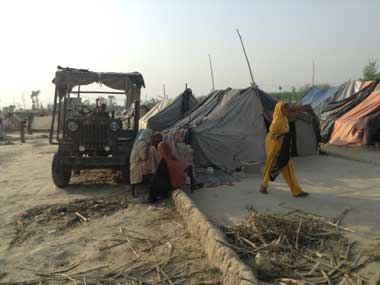From Mumbai-Mumbra to Ahmedabad-Juhapura, post-communal riot ghettoisation is almost a given, and the process is well underway in Muzaffarnagar, it appears. Exactly one year after what was described as the worst communal conflagration in Uttar Pradesh since the Babri masjid was demolished in 1992, Muslims in the riot-hit district of Western Uttar Pradesh have quietly redrawn the pockets they inhabit, slowly altering the demographics of the district. [caption id=“attachment_1570433” align=“alignleft” width=“380”]  File photo of a relief camp in Muzaffarnagar. Agencies[/caption] A multi-part series in The Indian Express visits the newly formed villages, peopled mainly by Muslim riot victims who purchased land near and around villages that have a significant Muslim population. These little settlements have new names, though they have neither water nor electricity and certainly no sanitation. “About five kilometres from what used to be the Idgah relief camp of Kandhla after the riots, three of the six women who filed FIRs alleging gangrape are among the 100-odd families who have bought plots of land, 100-200 gaj in size, from the Rs 5 lakh compensation they received from the state government. This includes 30 families from Fugana village, where the highest number of riot-related FIRs were filed, and others from Lakh, Lisadh, Bawdi and Hasanpur. The land was purchased from two Pathan families, traditional land owners in the village,” says one report in the series. There are serious hardships in living in a locality still to be recognised by the administration – a single handpump for a 100 houses, complete absence of medical facilities, no toilets. But obviously, there is safety in numbers. That safety in a crowd becomes that much more important when anything from a petty theft to an accident takes on communal hues. In the village of Kankra, from where three youngsters died when clashes broke out after a Jat mahapanchayat last year, 150 of the 250 Muslim families have sold their property to Jats. To add a further complex layer of hardship, the majority of these distress sales in the Muzaffarnagar-Shamli area at prices well below the market rates. Thos benefiting from the distress sale are Jat neighbours. This is the legacy of the riots, deeply polarised villages and whole regions. To understand more about the people’s anger, disappointment at the state machinery and the deep faultlines that have developed in Muzaffarnagar, read the entire series here.
These localities in Muzaffarnagar where Muslims are settling have neither water nor power, no sanitation nor any medical facilities.
Advertisement
End of Article


)

)
)
)
)
)
)
)
)



